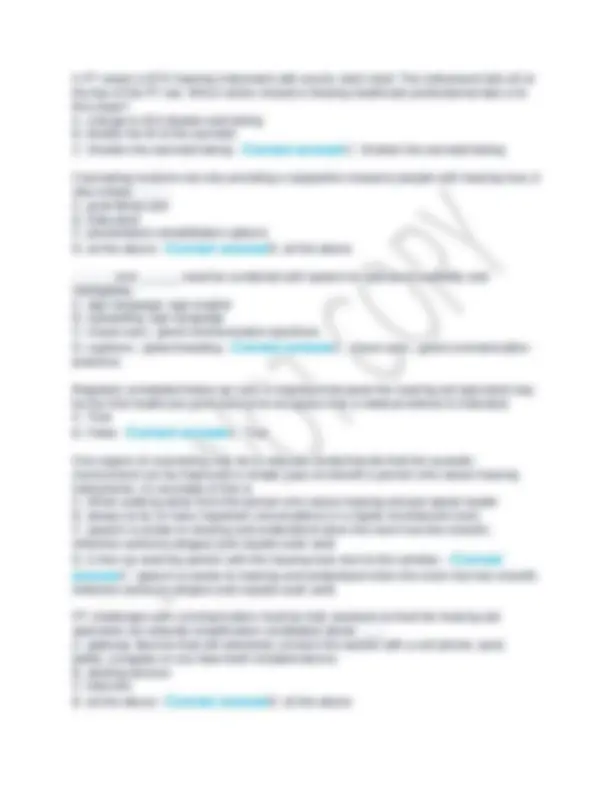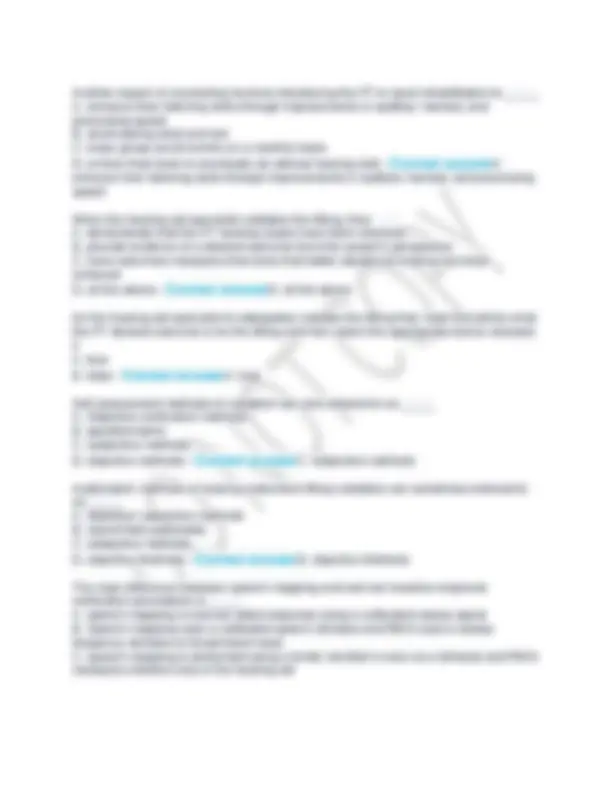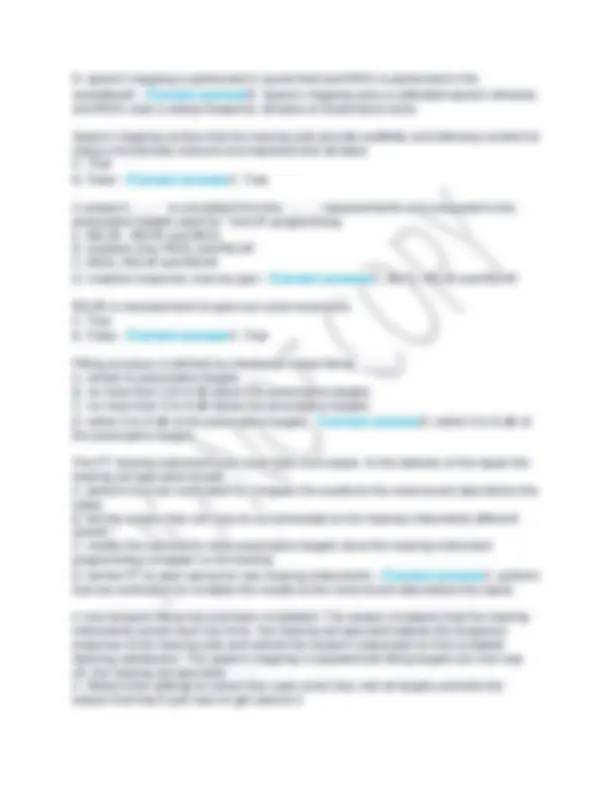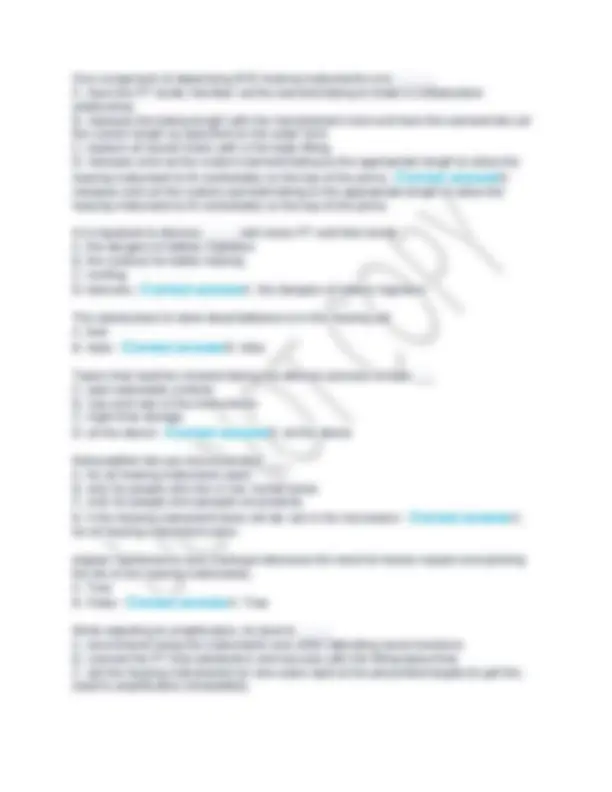







Study with the several resources on Docsity

Earn points by helping other students or get them with a premium plan


Prepare for your exams
Study with the several resources on Docsity

Earn points to download
Earn points by helping other students or get them with a premium plan
Community
Ask the community for help and clear up your study doubts
Discover the best universities in your country according to Docsity users
Free resources
Download our free guides on studying techniques, anxiety management strategies, and thesis advice from Docsity tutors
ILE Exam Sept 17th |50 Questions and Correct Solutions.ILE Exam Sept 17th |50 Questions and Correct Solutions.
Typology: Exams
1 / 9

This page cannot be seen from the preview
Don't miss anything!






A PT hearing evaluation reveals moderate symmetrical loss without air-bone gaps. WRS 60% in AS, 72% AD and 44% AU. The PT has never worn amplification. The case history reveals arthritis, diabetes, and macular degeneration. what is a possible contraindication for fitting both ears? A. bilateral recruitment B. poor binaural QuickSIN score C. poor bilateral fusion
A hearing healthcare professional is counseling a PT on hearing instrument use in noisy enviroments. what is the optimal seating location when dining with a group of four people in a busy restaurant? A. high table in lounge B. Square table by a window C. booth with high-back benches
benches A PT with moderate, gradually sloping hearing loss requests assistance hearing better at the PT's place of worship, which has recently been looped. Which feature should the hearing healthcare professional recommend? A. bluetooth B. Directional microphones C. Telecoils
A PT reports a longstanding history of untreated hearing loss. Testing confirms that the PT would benefit from amplification. Which information should be acquired from the PT before making a hearing instrument model recommendation? A. dominant hand B. PT living arrangments
A PT with moderate bilateral sensory/neural hearing loss has difficulty understanding speech in noise. The hearing healthcare professional is ordering canal hearing instruments. What should the hearing healthcare professional include to increase speech understanding in noisy enviroments? A. extended reciever tubes
B. Directional microphones C. digital volumes controls
In fitting hearing instruments, what is a difference in fitting someone with a conductive hearing loss versus someone with a sensorineural hearing loss? A. Conductive loss maximum output should be lower B. Conductive loss targets require less gain C. Conductive loss has narrower dynamic range
loss required greater gain for comfort. Which benefit is provided by a PT use of a telecoil? A. Provides a decrease in hearing instrument output B. Provides access to an assistive listening loop C. provides an increase in high frequencies
access to an assistive listening loop A PT demonstrates significant recruitment. Which parameter is critical to a successful fitting? A. gain B. venting C. output
What is a potential result of an undersize otoblock? A. an earmold with an excessively wide canal B. an impression that reaches the tympanic membrane C. an impression that reaches the eustachian tube
that reaches the tympanic membrane
refer to email for this question,
Inter-octave frequencies should be tested for pure tone audiometry when there is a minimum of how many decibles (dBs) between adjacent octaves? A. 40dB B. 10dB C. 20 dB
Another aspect of counseling involves introducing the PT to aural rehabilitation to _____ A. enhance their listening skills through improvements in auditory memory and processing speed B. avoid asking what and huh C. enjoy group social events on a monthly basis
enhance their listening skills through improvements in auditory memory and processing speed When the hearing aid specialist validates the fitting, they ____ A. demonstrate that the PT hearing issues have been resolved B. provide evidence of a desired outcome from the wearer's perspective C, have outcomes measures that show that better situational hearing has been achieved
for the hearing aid specialist to adequately validate the fitting they must first define what the PT desired outcome is for the fitting and then select the appropriate tool to measure it A. true
Self-assessment methods of validation are also referred to as _____ A. Objective verification methods B. questionnaires C. subjective methods
Audiometric methods of hearing instrument fitting validation are sometimes referred to as _____ A. objective/ subjective methods B. sound field audiometry C. subjective methods
The main difference between speech mapping and real ear insertion response verification procedures is _____ A. speech mapping is real ear aided response using a calibrated sweep signal B. Speech mapping uses a calibrated speech stimulus and REIG uses a sweep frequency stimulus or broad-band noise C. speech mapping is preformed using a family member's voice as a stimulus and REIG measures insertion loss of the hearing aid
D. speech mapping is preformed in sound field and REIG is preformed in the
and REIG uses a sweep frequency stimulus or broad-band noise Speech mapping verifies that the hearing aids provide audibility and listening comfort for using a functionally relevant and important test stimulus A. True
A wearer's _____ is calculated from the _____ measurements and compared to the prescriptive targets used for " first fit" programming A. REUR ; REAR and REIG B. insertion loss; REIG and REUR C. REIG; REUR and REAR
REUR is measurement of open ear canal resonance A. True
Fitting accuracy is defined as measured values being ______ A. similar to prescriptive targets B. no more than 3 to 8 dB above the prescriptive targets C. no more than 3 to 8 dB below the prescriptive targets
the prescriptive targets The PT hearing instrument just came back from repair. At the delivery of the repair the hearing aid specialist should____ A. preform real ear verification to compare the results to the most recent data before the repair B. tell the wearer they will have to accommodate to the hearing instruments different sound C. modify the earmold to meet prescriptive targets since the hearing instrument programming computer is not working
real ear verification to compare the results to the most recent data before the repair A new binaural fitting has just been completed. The wearer complains that the hearing instruments sound much too tinny. the hearing aid specialist adjusts the frequency response of the hearing aids and solicits the wearer's impression to find complete listening satisfaction. The speech mapping is repeated but fitting targets are now way off. the hearing aid specialist _____ A. Returns the settings to where they were when they met all targets and tells the wearer that they'll just have to get used to it
speech spectrum The SII represents the percent of the speech signal that is audible to the listener. A. True
verification ____ A. establishes that the wearer is using the hearing instruments by checking the datalog B. establishes that the wearer derives benefit and/or satisfaction from the fitting C. tests the accuracy with which the fitting has met prescriptive targets
which the fitting has met prescriptive targets Vailidation _____ A. establishes that the wearer is using the hearing instruments by checking the datalong B. establishes that the wearer derives benefit and/ or satisfaction from the fitting C. test the accuracy with which the fitting has met prescriptive targets
wearer derives benefit and/ or satisfaction from the fitting Perhaps the most important aspect of the real ear testing procedure is ___ A. adequate insertion of the probe tube B. the information that it provides regarding the wearer's benefit and/ or satisfaction from the fitting C. connecting the REM equipment to NOAH
adequate insertion of the probe tube Sound field measurements can be used as a fitting verification measure if REM equipment is not available. A. True
Functional gain is a sound field measurement that can _____ a fitting for _____ sounds A. validate ; soft B. Verify; loud C. validate ; loud
Best practices dictate that prior to the delivery electroacoustical and biological checks be preformed to ensure that the instrument is functioning properly. A. True
One component of dispensing BTE hearing instruments is to ______ A. have the PT family member cut the earmold tubing to foster a collaborative relationship B. measure the tubing length with the manufacture's tool and have the earmold lab cut the correct length as specified on the order form C. replace all sound hooks with a thin-tube fitting D. measure and cut the custom earmold tubing to the appropriate length to allow the
measure and cut the custom earmold tubing to the appropriate length to allow the hearing instrument to fit comfortably on the top of the pinna it is important to discuss _____ with every PT and their family A. the dangers of battery ingestion B. the contract for better hearing C. venting
The safest place to store dead batteries is in the hearing aid A. true
Topics that must be covered during the delivery process include ___ A. user-selectable controls B. Use and care of the instruments C. night time storage
Dehumidifier kits are recommended ____ A. for all hearing instrument users B. only for people who live in hot, humid areas C. only for people who perspire excessively
for all hearing instrument users regular maintenance and checkups decrease the need for factory repairs and prolong the life of the hearing instruments. A. True
While adjusting to amplification, its best to _____ A. recommend using the instruments only when attending social functions B. counsel the PT that satisfaction and success with the fitting takes time C. set the hearing instruments for new users right at the prescribed targets to get the, used to amplification immediately